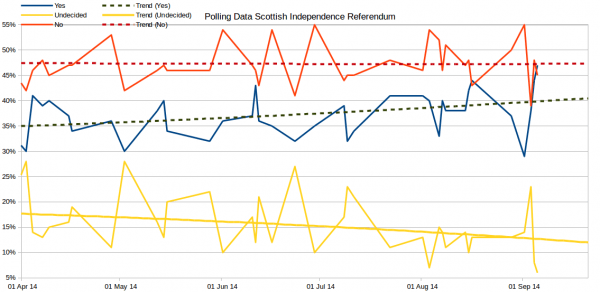Scottish Independence – Another View of the Polling Data
2
Since I posted the graph on the opinion poll data on the Independence Referendum in Scotland I’ve had some questions on both twitter and facebook (mainly from two of my three brothers still living in Scotland, one a clear Yes voter and the other undecided).
I was asked whether leaving out the undecideds was skewing the result that I was showing. My initial response to this was that it wasn’t, the analysis was looking at how the proportion of those deciding to vote was changing in favour of Yes. However I thought that I would go back and do the three way look at things and see if that gave a different picture.
Clearly the visual is very different, partly my choice in how to present it. However the story it tells is not different from the one I produced a couple of days ago. On the face of it the combined trend for Yes is growing faster than that for No, and people can be clearly seen to be making up their minds about how to vote. The margin between Yes and No is smaller than the total number of undecided people and when you also take into account the error margins it becomes rather too close for comfort regardless of which camp you might sit in. Both of the dotted lines show the general trend for the respective Yes & No scores for the opinion polls, and sit in the middle of the band of outcomes that individual polls have reported. So while No appears to be clearly above Yes, in reality there is a small overlap between the lower bound of No and the upper bound of Yes. The graph below shows this more clearly.
On balance a No vote is more likely than a Yes vote, but with just over a week to go and some strange behaviour in the media (their unconvincing stunt on the Last Queen of Scotland being evidence of them not letting a good story get in the way of scaring people to vote no) it can easily change.
If you are interested in knowing more about the opinion polls and what the people of Scotland (not all of whom are actually Scottish) think about things then http://whatscotlandthinks.org/ is a good place to start (with thanks to my other brother who pointed it out after I’d done all the hard work).
















I am your mum and I can’t believe you spout such a load of shite – well I can because you have been out of the loop for so long.
I was in the YES shop today and it was absolutely buzzing – people are coming in to get leaflets to convince DKs or Nos – this is a truly grassroots movement.
Two of your brothers are voting YES the other is still sitting on the fence – but I will be working on him.
Incidentally, the guy who came to my door yesterday, canvassing for Yes was English and told me he came from Cardross!
Constructive criticism is welcomed. Which parts of my analysis do you disagree with and why?
I can see that the Yes campaign is doing well, but from the polling data it suggests that it night not be doing well enough fast enough across Scotland. The advantage of using this method is that it gives an overview rather than a localise die which could be skewed. Especially when people could be scared of the reaction if they were honest.
What the polls say and what is happening on the ground are totally different. The bookies have also dropped the odds on a YES win. In 10 days we will know. Such exciting times!
That was largely the gist of my article. As an analyst I read the polls as being too close to call. The only real question is how fast can the Yes campaign pick up the Don’t Knows? If the rate of decision speeds up, and I would expect it to, and if the share of Don’t knows going to Yes stays constant, then it could be a narrow Yes result. Like Kennedy’s dad is reputed to have commented, there’s no point paying for a landslide when all you need is one more than the other guy.
On the other hand there is a lot of work still to do if you want to win, and the other side know that this is a real possibility now, so they’ll be upping their game too. The key thing is to keep the messages positive and avoid annoying people. Regardless of the result you’ll need to live with them afterwards.